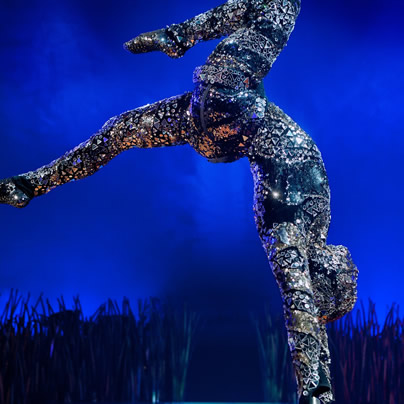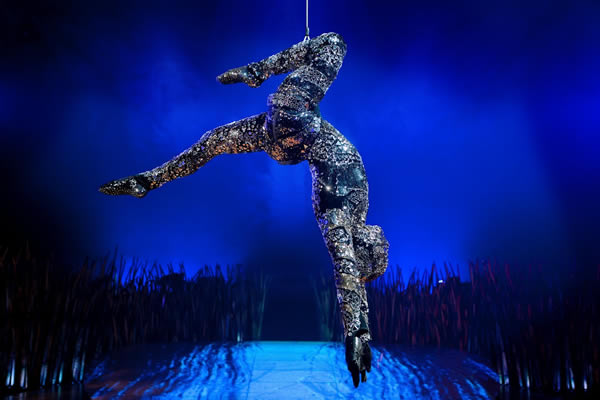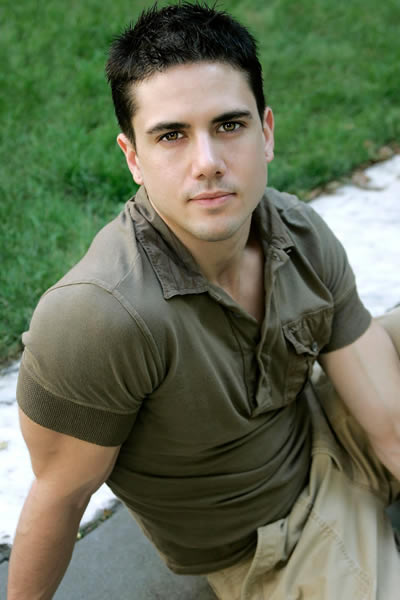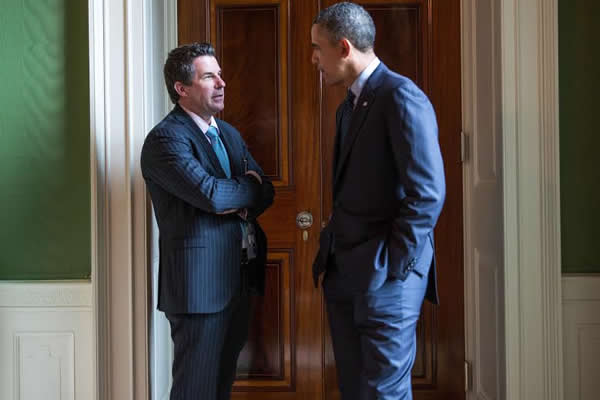Arts & Entertainment
Return to form
Gay Cirque performer in peak shape after conquering addictions


Joe Putignano says his passion for gymnastics never went away. Even in the throes of heroin addiction, he replayed his old routines in his mind. (Photo courtesy Cirque du Soleil)
Cirque du Soleil’s ‘Totem’
Aug. 15-Sept. 30
Plateau at National Harbor
201 Harbor View Ave.
Tickets: $40-$153
cirquedusoleil.com
Cirque du Soleil gymnast Joe Putignano prepares for his character in the big top show “Totem” by donning a dazzling costume containing eight pounds of Swarovski crystals. When he enters the arena, he descends from the ceiling illuminated in light.
“Totem,” which opens at the National Harbor on Wednesday, is a story about evolution, combining the scientific theories and myth that humans have developed about it. Putignano’s character, the Crystal Man, is the spark of hope and light that begins the journey. He says the character embodies Charles Darwin’s quote, “Light will be thrown on the origin of man.”
As he performs, audience members can sense the intensity and passion in the movement of his body. Company manager Jeff Lund describes him as a “human disco ball.” Putignano says, “It is difficult, performing in a heavy costume is like running a small machine and it does take a lot of practice.”
However, the audience will not realize that less than 10 years ago, the spark in Putignano’s life almost went out. At age 17, he began using various drugs, including ecstasy, cocaine and later heroin, and would not be clean again until he was around 29. When he was 19, he quit gymnastics thinking he would never return to the floor.
“I felt I betrayed myself,” he says. “I never wanted to do a handstand or a split again. It was like a divorce.”
Lund, who has worked with Putignano for almost two years and is in charge of almost all aspects of “Totem,” says Putignano’s performances these days defy his background.
“He is a world-class athlete,” he says. “His story is a very inspiring one.”
Putignano began gymnastics when he was around 8 years old, after watching the Olympic gymnasts compete on television. He says as he watched them, he knew he wanted to be doing this for the rest of his life.
He was immediately very good and began competing around the U.S. and went to the Olympic Training Center in Colorado Springs twice when he was 11 and 13.
“As a child you bend to the laws of passion,” Putignano says. “You can’t imagine as many people as passionate as you. Later you see that it is a sport and there are rules, and now everybody sees your imperfections.”
As a Boston native, he says competing in New England is different from competing with top gymnasts from around the country. For a young Putignano, the mounting pressure to reach perfection and to compete began to wear on him. Especially, as he describes, an injury can completely derail a gymnast from his path very quickly.
“We know that our art form is fleeting, we can’t take it for granted because it can leave you in a moment,” he says.
He says growing up with gymnastics made it feel like his church. Though he did not come out until he was 19, being gay and a gymnast was never an issue for Putignano. He says, “The floor has no sexuality.” But the increased competition felt like a violation of his sacred space.
Putignano began taking ecstasy and cocaine during the “’90s rave era” and eventually quit gymnastics when he was a sophomore in college.
“To be a gymnast, one has to conquer perfect precision and control over the physical capacities of the body,” he says. “To be an addict, one must surrender this control over to the underworld, and I couldn’t keep them both together.”
After walking away from competing, Putignano plunged into what would turn out to be a very dark 10 years. He moved to New York in 1999 and began using heroin. He says his experiences with the drug were full of “bitter irony.”
“The more I shot up to escape the memories of my once beautiful pure sport, the quicker I nodded out into a dreamscape of performing my old gymnastics routines,” he says. “I was shooting up to escape the memory of my failed destiny, only to be flooded into an unconscious heroin state where I performed my gymnastics skills over and over. If there was ever a layer of Dante’s inferno, this was it.”
In New York City, he worked various jobs like waiting tables and modeling. He tried to stop several times with no success.
“Eventually, I was getting older and hadn’t gotten any better and over the years I saw the tiny spark of light inside me dimming down to nothing,” he says. “That one thing which made me myself was going to burn out forever. The fear of losing this light kept me constantly chasing sobriety.”
As time went on, Putignano ended up homeless and overdosed twice where he was declared dead both times.
“At the time of my overdoses, I was so far from reality that I was actually strengthened by my experience because I believed I had beat death,” he says.
This cycle continued until he was 26, when he was in rehab for the fifth time. One day, he went up into his room and began doing headstands. Though it would be another three years before he was completely clean and intense training was required to get back in shape, his interest was rekindled. But sobriety did not come easily.
“When I started to audition for shows, I was still not completely clean,” Putignano says. “I would be three months clean and relapse.”
Putignano’s second chance in gymnastics came when he got clean and began performing at the Metropolitan Opera House and Broadway Bares. A pivotal turning point came for him when he was eventually hired by Twyla Tharp to perform in her Broadway show “The Times They Are A Changin,’” based on Bob Dylan’s music. This was important to Putignano, as he was rejected from the show twice before being hired.
“It was such an important point in my sobriety. Tharp is an icon in the dance world,” he says.
While performing on Broadway and the Opera house, he connected with Robert Lepage, one of the creators of Cirque du Soleil. Lepage knew Putignano’s background and asked him if he would like to be part of show. Putignano says it is not a coincidence that his character should represent hope and light in the world.
“For myself, my character represents my sobriety, my hope, my faith and the relentless power of the human spirit,” he says.
Now six days a week, he brings that light to others through the 4,000 pieces of reflective glass. And just like Putignano, Lund says the costume is far more durable than it seems.
“At the end of the night, it gets thrown in the wash with everything else,” he says. “Sometimes pieces will fall off, but we have people who will reattach them when it happens.”
With a tight performing schedule and around six years of sobriety under his belt, Putignano says remaining sober is still a challenge.
“I would love to say that touring has been easy for me in sobriety, but the truth is, it isn’t,” he says. “Some humans are like trees and they need to stay close to their roots. My sober network is in New York City and it has been difficult without them.”
Despite the challenge, he has remained clean so far and he is able to use his experiences to be an emotional support for other performers. He says since he has been in dark places himself, he can be empathetic to others’ emotional struggles.
Lund describes the “Totem” performers and crew as one big family. Nationality and sexuality do not matter there, he says.
“For me as a manager, I try to avoid making lines between artists and technicians and so on, “ he says. “I know in other companies it may be like that, but I like my entire crew to be connected with each other. This is made easy since we are on the road together for so much out of the year.”
What keeps Putignano going is the thought that many who have been in his position have not received a second chance.
“I have to continue to carry the torch for the dead, for those who didn’t get a second chance and I have to do everything in my power to bring hope to the hopeless,” he says. “I was once the hopeless.”
Another Cirque show to open in Baltimore
“Dralion,” Cirque du Soleil’s acrobatic show that fuses influences from the East and the West, is opening in Baltimore on Aug. 22 and runs through Aug. 26.
The name of the show represents the different parts of the world combined— it’s the combination of the dragon, representing the East, and the lion, representing the west. It mainly draws on the 3,000-year-old tradition of Chinese acrobatics combined with the more modern Cirque du Soleil twist, according to the website.
In the show, the four elements of nature come to life. At first they are separated and have their distinct colors. Air is blue, water is green, fire is red and earth is ochre. When they are combined balance is achieved.
“Dralion” is one of Cirque du Soleil’s arena shows, and is performing at the 1st Mariner Arena (201 West Baltimore St.) Tickets range from $40 to $165. For more information, visit cirquedusoleil.com.
Bars & Parties
Mixtape Sapphics hosts holiday party on Dec. 13
‘Sugar & Spice’ night planned for Saturday

Mixtape Sapphics will host “Sapphic Sugar & Spice: A Naughty-Nice Mixtape Holiday Party” on Saturday, Dec. 13 at 4 p.m. at Amsterdam Lounge.
This is a festive, grown holiday party for queer women and sapphics 35 and older at Revolt’s Christmas pop-up. There will be music, joy, and an optional White Elephant.
This is Mixtape Sapphics’ first-ever holiday party — a cozy, flirty, intentionally grounded night created just for queer women and sapphics 35+ who want real connection, festive joy, and a warm place to land at the end of the year.
Tickets start at $13.26 and can be purchased on Eventbrite.

Friday, December 12
“Center Aging Friday Tea Time” will be at 12 p.m. in person at the DC Center for the LGBT Community’s new location at 1827 Wiltberger St., N.W. To RSVP, visit the DC Center’s website or email [email protected].
Go Gay DC will host “LGBTQ+ Community Happy Hour” at 7 p.m. at Freddie’s Beach Bar and Restaurant. This event is ideal for making new friends, professional networking, idea-sharing, and community building. This event is free and more details are available on Eventbrite.
Women in Their Twenties and Thirties will be at 8 p.m. on Zoom. This is a social discussion group for queer women in the Washington, D.C. area. For more details, go to Facebook.
Saturday, December 13
Go Gay DC will host “LGBTQ+ Community Brunch” at 12 p.m. at Freddie’s Beach Bar & Restaurant. This fun weekly event brings the DMV area LGBTQ+ community, including allies, together for delicious food and conversation. Attendance is free and more details are available on Eventbrite.
The DC Center for the LGBT Community will host “Sunday Supper on Saturday” at 2 p.m. D.C.’s queer community will gather for good food, laughter, and community. For more information, email [email protected].
Sunday, December 14
SADBrunch will host “HokiSlay Drag Brunch” at 12 p.m. at Throw Social. This festive affair brings fierce performances, over-the-top holiday looks, and more sparkle than a tinsel explosion. Expect powerhouse lip-syncs, laughter, and cheer hotter than your spiked cocoa. Cake Pop will host the event. Tickets cost $28.52 and are available on Eventbrite.
Monday, December 15
“Center Aging: Monday Coffee Klatch” will be at 10 a.m. on Zoom. This is a social hour for older LGBTQ+ adults. Guests are encouraged to bring a beverage of choice. For more information, contact Adam ([email protected]).
Genderqueer DC will be at 7 p.m. on Zoom. This is a support group for people who identify outside of the gender binary, whether you’re bigender, agender, genderfluid, or just know that you’re not 100% cis. For more details, visit genderqueerdc.org or Facebook.
Tuesday, December 16
Center Bi+ Roundtable will be at 7 p.m. on Zoom. This is an opportunity for people to gather and discuss issues related to bisexuality or as Bi individuals in a private setting. Visit Facebook or Meetup for more information.
The DC Center for the LGBT Community will host “Self-Defense Class with Avi Rome” at 12:30 p.m. Rome is a proud member of the LGBTQ community and a full-time martial arts instructor with 25 years of teaching experience. He holds a Fifth Degree Black Belt in Jhoon Rhee Tae Kwon Do and is the director of the studio’s Adaptive Tae Kwon Do program for students with special needs. He has also run numerous self-defense workshops for various groups and situations. For more details, visit the center’s website.
Wednesday, December 17
Job Club will be at 6 p.m. on Zoom upon request. This is a weekly job support program to help job entrants and seekers, including the long-term unemployed, improve self-confidence, motivation, resilience and productivity for effective job searches and networking — allowing participants to move away from being merely “applicants” toward being “candidates.” For more information, email [email protected] or visit thedccenter.org/careers.
Asexual and Aromantic Group will be at 7 p.m. on Zoom. This is a space where people who are questioning this aspect of their identity or those who identify as asexual and/or aromantic can come together, share stories and experiences, and discuss various topics. For more details, email [email protected].
Thursday, December 18
The DC Center’s Fresh Produce Program will be held all day at the DC Center for the LGBT Community. People will be informed on Wednesday at 5 p.m. if they are picked to receive a produce box. No proof of residency or income is required. For more information, email [email protected] or call 202-682-2245.
Virtual Yoga Class will be at 7 p.m. on Zoom. This free weekly class is a combination of yoga, breath work and meditation that allows LGBTQ+ community members to continue their healing journey with somatic and mindfulness practices. For more details, visit the DC Center’s website.
Egypt
Iran, Egypt object to playing in Seattle World Cup ‘Pride Match’
Game to take place on June 26

Iran and Egypt have objected to playing in a “Pride Match” that will take place in Seattle during the 2026 World Cup.
The Egyptian Football Association on Tuesday said it told FIFA Secretary General Mattias Grafström in a letter that “it categorically rejects holding any activities related to supporting (homosexuality) during the match between the Egyptian national team and Iran, scheduled to be held in Seattle, USA, on June 26, 2026, in the third round of the group stage of the 2026 World Cup.” Football Federation Islamic Republic of Iran President Mehdi Taj told ISNA, a semi-official Iranian news agency that both his country and Egypt “protested this issue.”
The 2026 World Cup will take place in the U.S., Canada, and Mexico. The draw took place at the Kennedy Center on Dec. 5.
Iran is among the handful of countries in which consensual same-sex sexual relations remain punishable by death.
The State Department’s 2023 human rights report notes that while Egyptian law “did not explicitly criminalize consensual same-sex sexual activity, authorities regularly arrested and prosecuted LGBTQI+ persons on charges including ‘debauchery,’ prostitution, and ‘violating family values.’” Egyptian authorities “also reportedly prosecuted LGBTQI+ individuals for ‘misuse of social media.’”
“This resulted in de facto criminalization of same-sex conduct and identity,” notes the report.
The 2024 human rights report the State Department released earlier this year did not include LGBTQ-specific references.
Soccer has ‘unique power to unite people across borders, cultures, and beliefs’
The June 26 match between Iran and Egypt coincides with Seattle Pride. The Washington Post reported the Seattle FIFA World Cup 2026 Local Organizing Committee decided to hold the “Pride Match” before last week’s draw.
“As the Local Organizing Committee, SeattleFWC26’s role is to prepare our city to host the matches and manage the city experience outside of Seattle Stadium,” said SeattleFWC26 Vice President of Communications Hana Tadesse in a statement the committee sent to the Washington Blade on Wednesday. “SeattleFWC26 is moving forward as planned with our community programming outside the stadium during Pride weekend and throughout the tournament, partnering with LGBTQ+ leaders, artists, and business owners to elevate existing Pride celebrations across Washington.”
“Football has a unique power to unite people across borders, cultures, and beliefs,” added Tadeese. “The Pacific Northwest is home to one of the nation’s largest Iranian-American communities, a thriving Egyptian diaspora, and rich communities representing all nations we’re hosting in Seattle. We’re committed to ensuring all residents and visitors experience the warmth, respect, and dignity that defines our region.”
The 2034 World Cup will take place in Saudi Arabia.
Consensual same-sex sexual relations remain punishable by death in the country. The 2022 World Cup took place in neighboring Qatar, despite concerns over the country’s anti-LGBTQ rights record.
-

 Congress11 hours ago
Congress11 hours agoEXCLUSIVE: George Santos speaks out on prison, Trump pardon, and more
-

 The White House4 days ago
The White House4 days agoTrump’s shocking East Wing amputation—and the painful fallout Americans won’t ignore
-

 Health4 days ago
Health4 days agoThe harsh truth about HIV phobia in gay dating
-

 District of Columbia5 days ago
District of Columbia5 days agoThird LGBTQ candidate running for Ward 1 D.C. Council seat


















